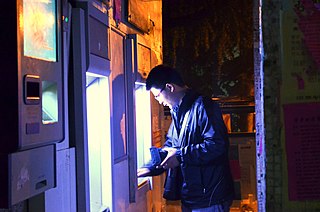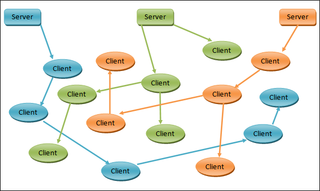
Streaming media is multimedia that is constantly received by and presented to an end-user while being delivered by a provider. The verb "to stream" refers to the process of delivering or obtaining media in this manner; the term refers to the delivery method of the medium, rather than the medium itself, and is an alternative to file downloading, a process in which the end-user obtains the entire file for the content before watching or listening to it.

Authentication is the act of proving an assertion, such as the identity of a computer system user. In contrast with identification, the act of indicating a person or thing's identity, authentication is the process of verifying that identity. It might involve validating personal identity documents, verifying the authenticity of a website with a digital certificate, determining the age of an artifact by carbon dating, or ensuring that a product or document is not counterfeit.

Video on demand (VOD) is a video media distribution system that allows users to access video entertainment without a traditional video entertainment device and without the constraints of a typical static broadcasting schedule. In the 20th century, broadcasting in the form of over-the-air programming was the commonest form of media distribution. As Internet and IPTV technologies continued to develop in the 1990s, consumers began to gravitate towards non-traditional modes of content consumption, which culminated in the arrival of VOD on televisions and personal computers.
A broadcast flag is a set of status bits sent in the data stream of a digital television program that indicates whether or not the data stream can be recorded, or if there are any restrictions on recorded content. Possible restrictions include the inability to save an unencrypted digital program to a hard disk or other non-volatile storage, inability to make secondary copies of recorded content, forceful reduction of quality when recording, and inability to skip over commercials.

A digital watermark is a kind of marker covertly embedded in a noise-tolerant signal such as audio, video or image data. It is typically used to identify ownership of the copyright of such signal. "Watermarking" is the process of hiding digital information in a carrier signal; the hidden information should, but does not need to, contain a relation to the carrier signal. Digital watermarks may be used to verify the authenticity or integrity of the carrier signal or to show the identity of its owners. It is prominently used for tracing copyright infringements and for banknote authentication.

Internet Protocol television (IPTV) is the delivery of television content over Internet Protocol (IP) networks. This is in contrast to delivery through traditional terrestrial, satellite, and cable television formats. Unlike downloaded media, IPTV offers the ability to stream the source media continuously. As a result, a client media player can begin playing the content almost immediately. This is known as streaming media.

Streamium was a line of IP-enabled entertainment products by Dutch electronics multi-national Philips Consumer Electronics. Streamium products use Wi-Fi to stream multimedia content from desktop computers or Internet-based services to home entertainment devices. A Streamium device plugged into the local home network will be able to see multimedia files that are in different UPnP-enabled computers, PDAs and other networking devices that run UPnP AV MediaServer software.

1080p is a set of HDTV high-definition video modes characterized by 1,920 pixels displayed across the screen horizontally and 1,080 pixels down the screen vertically; the p stands for progressive scan, i.e. non-interlaced. The term usually assumes a widescreen aspect ratio of 16:9, implying a resolution of 2.1 megapixels. It is often marketed as Full HD or FHD, to contrast 1080p with 720p resolution screens. 1080p can sometimes also be informally referred to as 2K.
Digital distribution is the delivery or distribution of digital media content such as audio, video, e-books, video games, and other software. The term is generally used to describe distribution over an online delivery medium, such as the Internet, thus bypassing physical distribution methods, such as paper, optical discs, and VHS videocassettes. The term online distribution is typically applied to freestanding products; downloadable add-ons for other products are more commonly known as downloadable content. With the advancement of network bandwidth capabilities, online distribution became prominent in the 21st century, with prominent platforms such as Amazon Video, and Netflix's streaming service starting in 2007.

P2PTV refers to peer-to-peer (P2P) software applications designed to redistribute video streams in real time on a P2P network; the distributed video streams are typically TV channels from all over the world but may also come from other sources. The draw to these applications is significant because they have the potential to make any TV channel globally available by any individual feeding the stream into the network where each peer joining to watch the video is a relay to other peer viewers, allowing a scalable distribution among a large audience with no incremental cost for the source.
The Broadcast Protection Discussion Group (BPDG) is a working group of content providers, television broadcasters, consumer electronics manufacturers, information technology companies, interested individuals and consumer activists. The group was formed specifically for the purpose of evaluating the suitability of the broadcast flag for preventing unauthorized redistribution and to determine whether there was substantial support for the broadcast flag. The group completed its mission with the release of the BPDG Report.

Gracenote, Inc. is a company owned by Nielsen Holdings which provides music, video and sports metadata and automatic content recognition (ACR) technologies to entertainment services and companies, worldwide. Gracenote's music recognition technologies compare digital music files to a worldwide database of music information, enabling digital audio devices to identify songs. The company licenses its technologies to developers of consumer electronics devices and online media players, who integrate the technologies into media players, home and car stereos, and digital music devices. The company operates five businesses: Music, Video, Sports, Automotive and Video Personalization. Headquartered in Emeryville, California, the company employs approximately 1,700 people in 20 offices around the world.
Video fingerprinting is a technique in which software identifies, extracts, and then summarizes characteristic components of a video recording, enabling that video to be uniquely identified by its resultant "fingerprint". This technology has proven to be effective at identifying and comparing digital video data.

Shazam is an application owned and developed by Apple Inc. The application can identify music, movies, advertising, and television shows, based on a short sample played and using the microphone on the device. The software is available for Android, macOS, iOS, watchOS, tvOS, and Windows.
The analog hole is a perceived fundamental and inevitable vulnerability in copy protection schemes for noninteractive works in digital formats which can be exploited to duplicate copy-protected works that are ultimately reproduced using analog means. Once digital information is converted to a human-perceptible (analog) form, it is a relatively simple matter to digitally recapture that analog reproduction in an unrestricted form, thereby fundamentally circumventing any and all restrictions placed on copyrighted digitally distributed work. Media publishers who use digital rights management (DRM), to restrict how a work can be used, perceive the necessity to make it visible or audible as a "hole" in the control that DRM otherwise affords them.
Civolution is a provider of technology and services for identifying, managing and monetizing audio and video media content. The company offers a portfolio of proprietary and patented digital watermarking and digital audio and video fingerprinting technology for media protection: forensic tracking of media assets in pre-release, digital cinema, Pay Television and online; media intelligence: audience measurement, broadcast monitoring, internet and radio tracking; media interaction: automatic content recognition and triggering for second screen and connected television.
Digimarc Corporation, a publicly traded technology company and inventor of several patented innovations, provides enterprise software and services for banking, retail, media, entertainment, publishing and several other industries.
An acoustic fingerprint is a condensed digital summary, a fingerprint, deterministically generated from an audio signal, that can be used to identify an audio sample or quickly locate similar items in an audio database.
Automatic content recognition (ACR) is an identification technology to recognize content played on a media device or present in a media file. Devices containing ACR support enable users to quickly obtain additional information about the content they see without any user-based input or search efforts. For example, developers of the application can then provide personalized complementary content to viewers.

Audible Magic Corporation is a Los Gatos, California-based company that provides content identification services to social networks, record labels, music publishers, and television and movie studios. The services help companies identify and protect copyrighted content, manage rights and monetize media.










